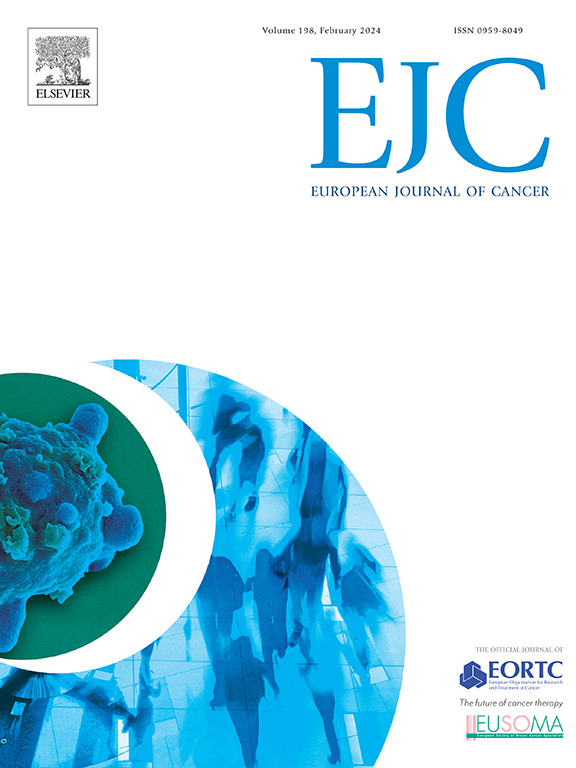舒法替尼治疗晚期神经内分泌肿瘤:两项随机、双盲、安慰剂对照的3期研究(SANET-ep和SANET-p)的最终总生存期
IF 7.6
1区 医学
Q1 ONCOLOGY
引用次数: 0
摘要
背景:sanet -ep (NCT02588170)和SANET-p (NCT02589821)在晚期胰腺外和胰腺神经内分泌肿瘤(NETs)患者中证明了与安慰剂相比,舒法替尼的有效性和安全性。在这里,我们对两项随机3期研究的最终总生存期(OS)进行了汇总分析。SANET研究是在中国进行的随机、安慰剂对照、双盲、3期研究,比较口服300 mg舒法替尼(n = 265)与安慰剂(n = 133)在不可切除/转移性、高分化NETs(1/2级)患者中的疗效和安全性。在疾病进展或研究解盲后,接受安慰剂的患者交叉/切换到开放标签的舒法替尼。通过汇总两项研究的数据,在意向治疗人群中使用Kaplan-Meier方法和Cox比例风险模型完成OS分析。采用不同的模型进行探索性分析,以纠正交叉引入的混淆效应。评估长期安全性。结果在研究结束时,69%的安慰剂组已经切换到舒法替尼。初始使用舒法替尼的患者和初始使用安慰剂的患者的中位OS分别为50.1和46.8个月(分层风险比[HR] 0.935, 95%可信区间[CI] 0.684-1.278; = 0.6727页)。校正交叉/切换引入的混杂效应后,HR范围为0.558 ~ 0.825。通常(≥10%)报告的治疗相关不良事件(3/4级)包括高血压和蛋白尿。结论:与最初使用安慰剂的患者相比,最初使用舒法替尼的患者的生存期并没有明显延长,这可能是由于从安慰剂到舒法替尼的大量交叉。没有观察到新的安全信号。临床试验注册sanet -ep (NCT02588170)和SANET-p (NCT02589821)本文章由计算机程序翻译,如有差异,请以英文原文为准。
Surufatinib in advanced neuroendocrine tumours: Final overall survival from two randomised, double-blind, placebo-controlled phase 3 studies (SANET-ep and SANET-p)
Background
SANET-ep (NCT02588170) and SANET-p (NCT02589821) demonstrated the efficacy and safety of surufatinib versus placebo in patients with advanced extra-pancreatic and pancreatic neuroendocrine tumours (NETs). Here, we present a pooled analysis of final overall survival (OS) from two randomised phase 3 studies.
Methods
The SANET studies were randomised, placebo-controlled, double-blind, phase 3 studies in China, comparing the efficacy and safety of oral 300-mg surufatinib (n = 265) versus placebo (n = 133) in patients with unresectable/metastatic, well-differentiated NETs (grade 1/2). After progression of disease or study unblinding, patients receiving placebo crossed over/switched to open-label surufatinib. By pooling the data from the two studies, OS analysis was completed using Kaplan–Meier methodology and a Cox proportional hazards model in the intention-to-treat population. Exploratory analyses were performed using different models to correct the confounding effect introduced by crossover. Long-term safety was assessed.
Results
At study termination, 69 % of the placebo group had crossed over/switched to surufatinib. Median OS was 50.1 versus 46.8 months for patients initially on surufatinib versus those initially on placebo (stratified hazard ratio [HR] 0.935, 95 % confidence interval [CI] 0.684–1.278; p = 0.6727). After correcting the confounding effect introduced by crossover/switching, the HR ranged from 0.558 to 0.825. Commonly (≥10 %) reported treatment-related adverse events (grade 3/4) included hypertension and proteinuria.
Conclusion
OS of patients initially on surufatinib was not significantly longer versus patients initially on placebo, likely due to the high amount of crossover from placebo to surufatinib. No new safety signals were observed.
Clinical trials registration
SANET-ep (NCT02588170) and SANET-p (NCT02589821)
求助全文
通过发布文献求助,成功后即可免费获取论文全文。
去求助
来源期刊

European Journal of Cancer
医学-肿瘤学
CiteScore
11.50
自引率
4.80%
发文量
953
审稿时长
23 days
期刊介绍:
The European Journal of Cancer (EJC) serves as a comprehensive platform integrating preclinical, digital, translational, and clinical research across the spectrum of cancer. From epidemiology, carcinogenesis, and biology to groundbreaking innovations in cancer treatment and patient care, the journal covers a wide array of topics. We publish original research, reviews, previews, editorial comments, and correspondence, fostering dialogue and advancement in the fight against cancer. Join us in our mission to drive progress and improve outcomes in cancer research and patient care.
 求助内容:
求助内容: 应助结果提醒方式:
应助结果提醒方式:


